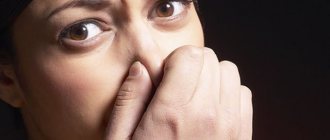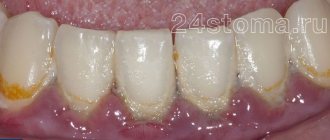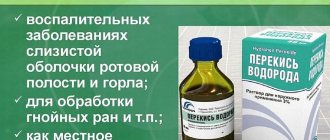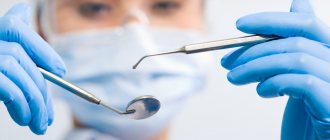Author of the article:
Soldatova Lyudmila Nikolaevna
Candidate of Medical Sciences, Professor of the Department of Clinical Dentistry of the St. Petersburg Medical and Social Institute, Chief Physician of the Alfa-Dent Dental Clinic, St. Petersburg
Today everyone knows the importance of healthy intestinal microflora, however, not every one of us thinks about the impact of oral microflora on the health of teeth, gums and the entire body as a whole. Let's talk about how, if necessary, probiotics can help restore the microflora of the oral cavity.
Microflora of the oral cavity
The human oral cavity is a unique ecological system. The permanent microflora in the mouth is formed by hundreds of different organisms; a moist, relatively warm environment creates favorable conditions for their reproduction.
The following play a significant role in the composition of the normal microflora of the oral cavity:
- veillonella, which neutralize acidic foods;
- bacteria of the genera Propionibacterium, Corynebacterium and Eubacterium, producing molecular oxygen;
- lactobacilli;
- rod-shaped lactobacilli - producers of lactic acid;
- bifidobacteria, necessary for the fermentation of carbohydrates and the production of B vitamins and others.
It is difficult to overestimate the importance of healthy oral microflora for the body. It is in this environment that the primary process of food digestion occurs, and therefore the absorption of vitamins and nutrients. Normal microflora is necessary for the proper functioning of the immune system and protecting the body from various fungal, bacterial and viral infections.
With the uncontrolled proliferation of opportunistic microflora and an imbalance of bacteria in the oral mucosa, oral dysbiosis occurs, an extremely unpleasant disease that provokes damage to tooth enamel and gums and can lead to extremely serious consequences for the entire body.
How do you know when it’s time to restore the microflora?
Untimely treatment of dysbiosis can lead to tooth loss. Therefore, at the slightest sign of disease, it is important to consult a dentist as soon as possible. Based on an examination of the oral cavity and test results, the doctor will prescribe effective treatment for the pathology and, if necessary, recommend probiotics and lactobacilli for the oral cavity.
Dentists divide dysbiosis into several stages:
- Dysbiotic shift is a mild increase in the number of one of the types of opportunistic microorganisms. The general composition of the microflora does not change.
- Subcompensated dysbacteriosis. The number of beneficial microorganisms decreases slightly against the background of increased activity of opportunistic bacteria.
- Monoculture, in which beneficial microorganisms are replaced by a pathogenic monoculture, and lactobacilli in the oral cavity are absent or remain in the form of traces.
- Decompensated, in which the microflora is populated by associations of pathogenic bacteria, as well as yeast-like fungi.
At the initial stage, dysbiosis manifests itself in the form of sticking in the corners of the mouth and an unpleasant odor. At later stages of development, the disease manifests itself with symptoms such as:
- dry mouth;
- coating on the tongue;
- tartar;
- unpleasant taste in the mouth;
- point inflammation on the gums;
- bad breath;
- compaction and blisters on the mucous membrane;
- regular inflammation of the tonsils.
Rating of the best remedies for bad breath
| Nomination | Place | Name | Price |
| Rating of the best remedies for bad breath | 1 | Miramistin | 369 ₽ |
| 2 | Hydrogen peroxide | 12 ₽ | |
| 3 | Chlorhexidine | 122 ₽ | |
| 4 | Iodinol | 42 ₽ | |
| 5 | Chlorophyllipt | 164 ₽ | |
| 6 | Imudon | 362 ₽ | |
| 7 | Stomatophyte | 290 ₽ | |
| 8 | Halita (Halita) | 320 ₽ | |
| 9 | Parodontax Extra | 230 ₽ | |
| 10 | Listerine "Fresh Mint", "Total Care" | 155 ₽ |
Miramistin
Rating: 4.9
Miramistin is a well-known, slightly foaming liquid without color, taste or smell, produced by the domestic company Infamed. The most popular package of 150 milliliters will cost, on average, from 280 to 380 rubles.
Miramistin belongs to quaternary ammonium compounds, and helps with an extremely large number of different infections, both for treatment and for prevention. You just need to rinse your mouth with Miramistin, since it is not able to be absorbed through the mucous membranes. It is necessary to irrigate or spray Miramistin in the mouth using a special nozzle - a sprayer, which is placed on the bottle and dispenses the antiseptic in an amount of 3-4 milliliters per serving. It is enough to rinse your mouth three to four times a day. For an adult, you need to press the nozzle three or four times to get the required dose.
Miramistin not only has a pronounced bactericidal effect against a wide variety of organisms, it also actively acts on various fungi that can multiply in the oral cavity, on viruses, as well as on sexually transmitted diseases.
Advantages and disadvantages
The big advantage of Miramistin is its excellent tolerability, as well as its effect on almost all known pathogenic and opportunistic bacteria, both aerobic and anaerobic, and on various fungi. If you swallow Miramistin by accident, then nothing bad will happen. Perhaps, as a modern antiseptic, Miramistin has no equal among quaternary ammonium compounds. But again, if the source of bad breath is air from the lungs, or it appears as belching from the esophagus, then no even the most effective antiseptic will be able to eliminate it, since the oral cavity is treated with an antiseptic, not the lungs, and not the gastrointestinal tract.
Hydrogen peroxide
Rating: 4.8
Hydrogen peroxide (hydroperite) is a cheap and popular antiseptic, which, meanwhile, is very active and works very well, despite its cheapness. So, a bottle with a volume of 100 milliliters, a concentration of 3%, will cost from 6 to 12 rubles. in our rating. This is a very low cost.
It is imperative to remember that a concentration of 3% is only suitable for external use, and in order to rinse the mouth and throat, this is too strong a solution, and if you rinse with undiluted peroxide, there may be burns, whitening of the mucous membrane and unpleasant sensations. In order to properly dilute hydrogen peroxide for rinsing your mouth and throat, you need to add 11 parts of water to one part of the preparation. As a result, we get a weak solution with a concentration of 0.25%. It is quite enough for hydrogen peroxide to interact with microorganisms, with pus, with necrotic masses, with saliva.
As a result of this effect, hydrogen peroxide, as an unstable compound, breaks down into water and active oxygen. Oxygen is the active substance, since it enters into a chemical reaction with organic substances - substrates for the proliferation of microbes and mechanically cleanses the mucous membrane. You need to rinse your mouth with hydrogen peroxide 2 times a day.
Advantages and disadvantages
The big advantage of hydrogen peroxide is its low cost, widespread use, and the ability to use it to disinfect various wounds, cuts, and bites. Hydrogen peroxide is always needed in the household. Thus, it can even be used to increase the germination of seeds of some flower and vegetable crops. Hydrogen peroxide has an antifungal effect, and can be used to treat the inside of shoes. The downside will be the need to dilute the medicine with water 11 times before use, as well as the possibility of developing adverse reactions - burning and redness of the oral mucosa. Naturally, a 3% hydrogen peroxide solution must be hidden from children.
Chlorhexidine
Rating: 4.8
The second cheapest champion is the well-known antiseptic Chlorhexidine, which is available in the form of chlorhexidine bigluconate, with a concentration of 0.05%. These are bottles of 100 and 200 ml. For rinsing, it is most convenient to buy a 200 ml bottle, which has an average cost of 28 to 165 rubles. It is produced by the domestic Samara pharmaceutical factory. Attention! On sale there is simply Chlorhexidine, which is diluted in ethyl alcohol, and Chlorhexidine bigluconate, which is sold in the form of an aqueous solution.
The bacteriostatic effect is manifested already in a concentration of 0.01% solution or less, and the existing commercial concentration is 5 times stronger, and it ensures the destruction of microorganisms, that is, it exhibits a bactericidal effect. It is necessary to rinse the oral mucosa 2 to 3 times a day, but the rinsing time required to achieve the effect is at least 2-3 minutes.
Advantages and disadvantages
Chlorhexidine, unfortunately, cannot kill fungi in the mouth if you rinse your mouth for less than 10 minutes. Therefore, if the patient has a fungal infection of the oral cavity, it is better to use hydrogen peroxide or Miramistin. If the source of bad breath is viral stomatitis, then it is also necessary to use Miramistin better. Chlorhexidine can also cause allergic reactions, burning in the mouth and redness of the mucous membrane. Sometimes chlorhexidine leads to changes in the color of teeth, tartar begins to be deposited, and with its long-term use, a taste disturbance occurs. But it really should be long-term use - for one month or longer. But if you accidentally swallow a chlorhexidine solution, it is practically not absorbed. When rinsing, avoid getting chlorhexidine into your eyes, and if this happens, rinse your eyes thoroughly with water.
Iodinol
Rating: 4.8
The next antiseptic that is successfully used for bad breath is Iodinol. This is nothing more than polyvinyl alcohol in which potassium iodide is dissolved. It is a good antiseptic and disinfectant. There is no burning solvent here, it is an aqueous solution. Every 100 milliliters of solution contains 0.1 grams of iodine, 0.3 g of potassium and 0.9 grams of polyvinyl alcohol. Moreover, iodine in this solution is combined with alcohol, and separately iodine is also included in the potassium salt. This is a dark blue liquid with a specific odor of iodine.
It is indicated for washing the tonsils, for instillation into the ears for purulent otitis, for inhalation for atrophic rhinitis, and for the treatment of purulent wounds. In particular, you can rinse the oral mucosa with Iodinol if there is an unpleasant odor. Rinsing - in a volume of 20-30 milliliters per single procedure, the frequency of rinsing is once or twice a day, but not longer than a week. One 100 ml bottle of Iodinol will cost from 12 to 25 rubles.
Advantages and disadvantages
The advantage of Iodinol is its fairly high effectiveness against standard microorganisms, which most often cause putrefactive infections and bad breath. The disadvantage may be an excessive intake of iodine into the body, so Iodinol should never be swallowed. It is not advisable to use it in persons with thyroid pathology, including hyperthyroidism, diffuse toxic goiter, myxedema, or insufficient thyroid function. But, when prescribed in moderate dosage, it perfectly copes with its function and freshens the breath of dental patients.
Chlorophyllipt
Rating: 4.7
The next drug from the group of herbal disinfectants is Chlorophyllipt. It is available in the form of a solution for topical and external use, and for bad breath, it is best used in the form of lozenges. Chlorophyllipt is an extract of eucalyptus leaves, it is produced by the domestic pharmaceutical company Vifitech, and the cost of one package of 20 tablets ranges from 80 to 135 rubles.
The range of indications for resorption of chlorophyllipt tablets is much wider than halitosis, or bad breath. These are nasopharyngitis, tonsillitis, acute and chronic bronchitis, periodontal disease and inflammation of the gums - gingivitis, inflammation of the oral mucosa or various types of stomatitis. The extract from eucalyptus leaves not only has a bactericidal, antiviral and antifungal effect. It is also capable of producing antiprotozoal and anti-inflammatory effects, meaning it fights protozoa and reduces swelling, redness and pain. These are the valuable qualities of Chlorophyllipt in general, and eucalyptus leaves in particular, manifested thanks to the essential oil of caeniol. It is necessary to dissolve one tablet three to four times a day until the effect is achieved.
Advantages and disadvantages
Chlorophyllipt tablets are well tolerated, it rarely causes allergies, and almost never causes redness and burning in the mouth. However, if the patient has gastritis with high acidity, then it is advisable not to swallow, but to spit out saliva, since the essential oils included in the extract, including cineole, terpenes, pinenes, can cause irritation to the gastric mucosa and lead to heartburn, or increased pain.
We deliberately do not list here a large number of different mint sprays and fruit tablets, which can be purchased in abundance at retail pharmacies. Hobby and collection of various local drugs to fight off bad breath in search of the best can become an end in itself, and even a mania, instead of going to the doctor. Therefore, in this review, we deliberately limited the list of drugs to the most necessary and effective.
If you try to cope with bad breath, then, in addition to using various medications, you should also brush your teeth with a paste with a strong mint smell; you can suck on various medicinal mint candies, but only without sugar. You can chew coffee beans; a good effect comes from long-term rinsing of the mouth for 5-7 minutes with vegetable oil, which can sometimes absorb various odors much better than any aqueous solutions. It is quite acceptable to periodically chew some spices to treat halitosis. This could be cloves, dried purple basil leaves, fennel leaves, a small piece of nutmeg, or a very small piece of vanilla bean.
Imudon
Rating: 4.7
The next drug to improve bad breath is also suckable tablets, and for a pack of 40 such tablets you will have to pay from 330 to 470 rubles. The drug Imudon is produced by Solvay Pharma, which is located in Bulgaria. Imudon, as the name suggests, is related to immunity. These are specially lysed, that is, destroyed, microorganisms, which are precisely part of the pathogenic and opportunistic flora that cause various diseases of the oral cavity. These are gingivitis, aphthous ulcerative stomatitis, periodontitis, inflammation of the tongue, or glossitis. Of course, Imudon was not specifically developed to treat halitosis and eliminate bad breath. The goal of the manufacturers was to improve local immunity so that sore throats, that is, acute tonsillitis, chronic tonsillitis, and pharyngitis, develop as rarely as possible and proceed more easily.
Therefore, those pathogens that most often threaten oral health were taken. Among them: group A streptococci, various staphylococci, Klebsiella and enterococci, fusobacteria and candidiasis pathogens, that is, candida albicans. Systematic resorption of the drug Imudon causes harmless but immunogenic polysaccharide residues, characteristic of each type of pathogen, to enter the mucous membrane, which react with immunoglobulins. They trigger a “sentinel” cascade of immune reactions. As a result, phagocytosis is activated in the oral cavity and the production of protective secretory immunoglobulin class A is stimulated.
The secretion of not only lysozyme, but also interferon, which has an antiviral effect, complementarily increases, despite the fact that Imudon contains a bacterial lysate, but no specific viral proteins are found there.
It is clear that if halitosis is caused by bacteria, then increasing immune defense will at least, if not destroy, then reduce their vital activity. Therefore, Imudon also eliminates bad breath, even if there are infected food debris left on the dentures. This sometimes happens when dentures are chosen incorrectly, or the rules for wearing them are violated. The drug should be used by dissolving tablets every hour, 8 tablets per day, for 10 days. You can also take a prophylactic course, then dissolving 6 tablets a day in two hours is enough, but the duration of the course is then longer: for 3 weeks.
Advantages and disadvantages
Naturally, the immune drug does not act as actively and quickly as antibiotics or antiseptics. Therefore, it is best to use Imudon as part of complex therapy, together with antiseptic rinses. A relative minus is the rather generous application scheme. It turns out that a package of 24 tablets will run out in three days, and to complete the entire course, you need to pay about 1,000 rubles. Therefore, it is advisable to purchase Imudon only together with antiseptic throat lozenges, or with other drugs that act together. As a last resort, you can gargle and rinse the nasal cavity with sea water (Aquamaris), and then dissolve Imudon. This will also improve the condition of the oral cavity.
Stomatophyte
Rating: 4.7
Another effective liquid remedy for the treatment and prevention of bad breath is Stomatofit extract, produced by the Fitofarm company from Poland. It is available in bottles of half a glass, that is, 100 ml, and costs from 250 to 300 rubles. This is a multi-component herbal remedy. It includes sage leaves, calamus rhizomes, thyme and arnica herbs, chamomile flowers, oak bark and mint leaves. As a result, the drug has an anti-inflammatory, drying and soothing effect on the mucous membrane.
It is used for stomatitis, gingivitis and periodontitis, that is, for all those diseases that can cause bad breath. The drug should be used by diluting 7.5 ml of extract in a quarter glass of warm boiled water. It is necessary to rinse your mouth with this composition, and then repeat the procedure 3-4 times a day, the course duration is up to 2 weeks. For ease of dosing of the extract, a measuring cup is attached to it.
Advantages and disadvantages
Stomatophyte may well give fresh breath and soothe diseases of the oral cavity, especially if obvious inflammation and exacerbation have already been stopped with the help of antibiotics and antiseptics. This remedy can be used perfectly for prevention. But if there is severe inflammation, then, as in the case of Imudon, taken separately, Stomatofit will not be able to cope with serious problems. Therefore, it is worth purchasing it only in two cases: the first case is if a dentist or ENT doctor actually prescribed Stomatofit to you, and there are indications, and the second case is if there is no active inflammation and you do not have any complaints, but you Are you going to use Stomatofit as a prophylactic agent?
Halita (Halita)
Rating: 4.7
The next parapharmaceutical product for freshening breath and eliminating unpleasant odor from the mouth is called Halita. We know that halitosis is the presence of bad breath. Therefore, this product is specially created to eliminate unpleasant odors. This positioning made it possible to raise the price, and for one bottle of 150 ml, which is still less than a glass, you have to pay about 320 rubles. As a result, this product turned out to be about four times more expensive than other rinses.
What is unique about Galit? Many rinses contain fluorine and hydroxyapatite, but Halite contains neither the first nor the second component. But this mouth rinse has a glycerin base to eliminate bad odor. It contains chlorhexidine and zinc lactate. Chlorhexidine disinfects, and the absence of hydroxyapatite and fluoride makes it possible to exclude abrasive materials, which, although they clean teeth, can cause harm. Instead, propylene glycol, castor oil, and gluconic acid were added. Chlorhexidine allows you to disinfect the oral cavity for up to 8 hours after one rinse.
Another antiseptic, cetylpyridinium chloride, has been added to this composition. It does not act as long as Chlorhexidine, for 4-5 hours, but its presence can prolong the exposure time of Chlorhexidine. A component such as the bond of zinc with lactic acid, or zinc lactate, interacts with sulfur compounds, and sulfur is formed in the oral cavity due to the activity of various bacteria. It adds a stench, at least due to hydrogen sulfide. In addition, xylitol provides a sweetish taste, in addition to glycerin. And xylitol is not metabolized by microbes and is not a nutrient medium for them.
As a result, Halita is a drug that, through the work of many components, allows you to destroy pathogenic flora and freshen your breath. This rinse is used morning and evening. For the procedure, take a 15 ml cap and rinse your mouth for 30 seconds. To achieve the best effect, it is advisable to use special tongue scrapers, brush your teeth well before use, and also use dental floss. The drug is indicated for adults, as well as children over 6 years of age.
Advantages and disadvantages
This rinse is thought out from the point of view of the prescription most deeply and completely, the protection is built in several rows, it does not contain abrasive compounds, and at the same time protects well from the proliferation of pathogenic microbes. Therefore, the only drawback can be called a small volume at a relatively high price. In addition, this rinse aid can hardly be purchased at retail in a regular pharmacy, but it is quite possible to order it in special online stores.
And one more thing: a contraindication for children under six years of age does not at all indicate that this remedy will be harmful for children, say, 5 years old. It’s just that children are not yet very good at rinsing their mouths properly while keeping it closed. Therefore, it is quite possible that babies will either spit out this expensive drug, or children will accidentally swallow it. This age limit is made for child safety purposes, and nothing more.
Parodontax Extra
Rating: 4.7
Another mouthwash that successfully combats harmful odors is Parodontax Extra. This is a well-known line, these rinses can be purchased in supermarkets, and even in hardware stores. It does not contain ethyl alcohol, but just like the previous drug, it contains an antiseptic - chlorhexidine bigluconate. Chlorhexidine is present in a concentration of 0.2%, which is safe for rinsing the mouth.
Chlorhexidine is both a bactericidal and bacteriostatic antiseptic, and it is capable of stopping the vital activity and reproduction of a large number of representatives of opportunistic and pathogenic flora that form dental plaque. These include some fungi, yeasts, cocci, representatives of anaerobic and aerobic flora, various rods, fusobacteria and spirilla. They can provoke a large number of diseases of the teeth, oral mucosa and gums. Most often, according to dentists, halitosis develops against the background of either periodontitis or sluggish gingivitis, especially in the presence of anaerobic flora.
Typically, microorganisms do not tolerate chlorhexidine very well, since it is almost never included in commonly used toothpastes. Therefore, microbial resistance to chlorhexidine, furatsilin, potassium permanganate, and similar antiseptics is simply not developed. And chlorhexidine, in a few tens of seconds or a minute, destroys all “unnecessary” microbes during rinsing. This rinse contains ingredients that, like surfactants, coat the teeth and gums and help retain the rinse on them. As a result, it lasts somewhere around 10-12 hours after a single rinse. Unless, of course, at this time the patient spent time at the festive table with a hearty meal.
On average, this remedy should be used for two weeks, but not longer than 1 month. You need to rinse as usual, filling the cap with product, and rinse twice a day for at least a minute. Moreover, it is advisable to do this in the morning after toileting the oral cavity, and in the evening - also after brushing your teeth before going to bed. The average cost of this rinse aid is about 250 rubles. for a 0.5 liter bottle, which will last for a long time.
Advantages and disadvantages
This medication does not contain ethyl alcohol (ethanol), and there is no perfume or fragrance. Therefore, those people who are allergic to various odors, or cannot tolerate aromas, positively take this mouthwash. But its original color means that if it is used too often and for a long time, it can change the color of tooth enamel. This rinse should not be used if you are allergic to chlorhexidine.
Plus - in dentistry it is also used not only for treatment, but also for the prevention of various inflammatory diseases of the oral cavity. You can also use it to disinfect the oral cavity immediately before a visit to the dentist, for treatment and removal of teeth. But after the visit, you need to use the mouthwash only when the doctor allows it. After all, if you have a fresh filling, it may take on the color of the rinse aid. And if you have a tooth removed, a blood clot should form in the socket. If you start rinsing immediately after extraction, bleeding may occur, you need to remember this.
Listerine "Fresh Mint", "Total Care"
Rating: 4.7
There is a whole family of “Listerines”, for example, “total care” Listerine contains sorbitol, propylene glycol, eucalyptus oil, zinc chloride, benzoic acid? methyl salicylate, thymol, phosphates, menthol and other ingredients. Another Listerine scent is the scent of fresh mint, but all members of the Listerine line contain eucalyptus oil, methyl salicylate, menthol and thymol, and the color and aroma depend on the fragrance.
The effect of using this drug is quite good; it acts not only on pathogenic, but also on opportunistic flora. Even in the modern era, it became fashionable to rinse the mouth with a weak alcohol solution with various essential oils. Currently, they have learned to dissolve essential oils without alcohol, but they impair the activity of bacteria, heal tooth enamel, and give fresh breath.
It is advisable to use this drug for halitosis twice a day, and also after brushing your teeth. 20 ml, or half a cap, is enough to rinse your mouth for half a minute. All Italian-made Listerine preparations reduce plaque and prevent the formation of tartar. Listerine is manufactured in Italy, under the control of the world famous cosmetic and medical giant Johnson & Johnson.
Advantages and disadvantages
This is a truly effective remedy, confirmed by clinical trials. It turned out that Listerine effectively breaks down plaque, penetrates deeply through all its layers, and helps strengthen the gums. After just one application, you can get rid of the unpleasant odor, and the Listerine line of products allows you to choose the aroma to your liking and start using the product for your pleasure. In addition to the sweet mint flavor, there is Listerine "total protection", "green tea extract", and even a children's version of Listerine "strong teeth and healthy gums". As usual, mouthwashes can be used in children from the age of six. Listerine is also inexpensive; for a large bottle of 500 ml you will have to pay from 200 to 400 rubles, with an average price of 300 rubles. per bottle. A small package of 250 ml on average will cost 190 rubles. Therefore, this is a fairly democratic and useful tool, without any particular disadvantages.
Oral probiotics (oral probiotics)
Probiotics are live microorganisms that promote the growth of friendly microbiota. Most often, such substances are used to improve intestinal microflora, but not many people know that there are probiotics for the oral cavity.
It is important to understand that probiotics for the oral cavity are represented by one group of substances, and probiotics for the intestines are a completely different one. Scientific research regarding these drugs is very controversial, so dentists recommend using them only as an addition to the prescribed treatment for dysbiosis.
Clinical researches
Asept products have proven effectiveness. For example, multiple clinical studies have proven that regular use of preventive toothpaste ASEPTA ACTIVE for a month can reduce bleeding gums by 60%, improve the overall condition of the oral cavity by 44% and reduce inflammation by 33%.
Clinical studies have also proven that regular use of preventive toothpaste ASEPTA SENSITIVE for a month can reduce bleeding gums by 62%, reduce sensitivity of teeth and gums by 48% and reduce inflammation by 66%.
Sources:
- Clinical and laboratory assessment of the influence of domestic therapeutic and prophylactic toothpaste based on plant extracts on the condition of the oral cavity in patients with simple marginal gingivitis. Doctor of Medical Sciences, Professor Elovikova T.M.1, Candidate of Chemical Sciences, Associate Professor Ermishina E.Yu. 2, Doctor of Technical Sciences Associate Professor Belokonova N.A. 2 Department of Therapeutic Dentistry USMU1, Department of General Chemistry USMU2
- Clinical studies of antisensitive toothpaste “Asepta Sensitive” (A.A. Leontyev, O.V. Kalinina, S.B. Ulitovsky) A.A. LEONTIEV, dentist O.V. KALININA, dentist S.B. ULITOVSKY, Doctor of Medical Sciences, Prof. Department of Therapeutic Dentistry, St. Petersburg State Medical University named after. acad. I.P. Pavlova
- Comparative clinical evaluation of the effectiveness of treatment of traumatic lesions of the oral mucosa IORDANISHVILI A.K. *,** Doctor of Medical Sciences, Professor, Professor of the Department *Department of Orthopedic Dentistry of the Federal State Budgetary Educational Institution of Higher Education “North-Western State Medical University named after. I.I. Mechnikov" of the Ministry of Health of the Russian Federation (rector - Doctor of Medical Sciences Sayganov S.A.); **Department of Maxillofacial Surgery and Surgical Dentistry of the Federal State Budgetary Military Educational Institution of Higher Education “Military Medical Academy named after S.M. Kirov" of the Ministry of Defense of the Russian Federation (chief - Corresponding Member of the Russian Academy of Sciences, Professor A.Ya. Fisun).
- The role of anti-inflammatory rinse in the treatment of periodontal diseases (L.Yu. Orekhova, A.A. Leontyev, S.B. Ulitovsky) L.Yu. OREKHOVA, Doctor of Medical Sciences, Prof., Head of Department; A.A. LEONTIEV, dentist; S.B. ULITOVSKY, Doctor of Medical Sciences, Prof. Department of Therapeutic Dentistry of St. Petersburg State Medical University named after. acad. I. P. Pavlova
How do probiotics work?
Dysbacteriosis and inflammatory processes in the oral cavity very often cause not only local discomfort, but also discomfort in the gastrointestinal tract and bad breath. Antibiotics, along with pathogenic microorganisms, begin to destroy the beneficial bacteria necessary for humans.
Probiotics are live strains of “friendly” bacteria and bring invaluable benefits to the body:
- help destroy pathogenic microorganisms;
- promote the regeneration of damaged tissues;
- activate the immune system;
- normalize cell metabolism;
- prevent cells from degenerating into malignant formations;
- restore the balance of fluid and beneficial microorganisms;
- prevent allergies;
- removes unpleasant odors from the mouth;
- eliminate toxins produced by pathogenic microorganisms.
Types of Oral Probiotics
Biologists call the most common types of probiotics:
- Lactobacillus and Bifidobacterium (Lactobacillus and bifidobacteria), obtained mainly from dairy products. However, it is important to normalize the population of these bacteria, but not to “overdo it” with them, since their excessive quantity provokes the formation of caries.
- Bacterial strains Bacillus subtilis, L. salivarius WB21, L. casei Shirota, L. brevis, L. reuteri, L. acidophilus may be useful in the treatment of periodontal diseases.
- Candidiasis, the most common cause of oral dysbiosis, can be treated with L. rhamnosus strains (GG and LC705) as well as Propionibacterium freudenreichii ssp. shermanii JS. This type of oral probiotic can be obtained from cheese or other fortified dairy products.
- To treat halitosis (bad breath), probiotics E. coli Nisle 1917 and S. salivarius K12 can be used.
Is halitosis a disease or a consequence of poor hygiene?
There are main causes of halitosis:
- Failure to comply with the rules of personal oral hygiene, when peptides from food debris and saliva proteins lead to aminolysis (putrefactive breakdown of amino acids).
- The presence of orthopedic and orthodontic structures in the oral cavity in conditions of neglect of hygiene.
- Diseases of the gastrointestinal tract.
- Xerostomia or dry mouth syndrome.
- Less obvious sources of odor: foods such as garlic, onions, milk, cheese and yogurt.
- Heredity: congenital gallbladder defect, diabetes mellitus, if the hormonal status is disturbed in the same way as in close relatives (mother, grandmother, father, etc.)
Dental series of oral hygiene products are produced at pharmaceutical enterprises in leading countries according to the ISO International Quality System under the guidance and supervision of specialists. Each individual product effectively solves certain problems.
Treatment of dysbiosis
Remember, a disorder of the oral microflora is a complex, multifaceted and very individual disease that cannot be cured solely with probiotics. Such substances are used only as adjuvant therapy.
Dysbacteriosis should be treated only by a dentist based on smears from the mucous membrane. Therapy should be selected taking into account the general condition of the body and associated pathologies.
As a rule, the treatment of dysbiosis involves a whole range of measures and includes:
- rinsing the mouth with disinfectant solutions;
- use of special medicated toothpastes;
- the use of drugs aimed at restoring normal microflora with bifidobacteria and lactobacilli;
- taking lozenges, tablets and lozenges to eliminate pathogenic microorganisms and simultaneously restore normal microflora;
- changing the diet - including vitamin supplements in order to activate the body’s protective properties;
- taking immunomodulatory drugs to stop the development of pathogenic microflora and increase immunity;
In rare cases, with dysbiosis, dentists may prescribe antibiotics.
An assistant in restoring the microflora of the oral cavity is the probiotic complex ASEPTA PARODONTAL. This is an excellent source of lactobacilli for restoring the microflora of the oral cavity - it not only normalizes the bacterial microflora in the mouth, but also prevents the formation of biofilms of pathogenic microorganisms, reducing the formation of dental plaque - one of the factors in the occurrence of periodontal inflammation and caries.
So now you know a lot about probiotics and oral lactobacilli. We hope that you will not need treatment with such supplements, and the state of your microflora will always be excellent.
How to get rid of halitosis
1. You can restore fresh breath with medications. Popular remedies for halitosis are anti-inflammatory and antibacterial drugs. Serious diseases are treated with potent tablets, but halitosis is not one of them. You can get rid of it in safer ways.
2. Start with hygiene. Brush your teeth for at least 2 minutes twice a day. There are special antihalitosis toothpastes that contain additives with antimicrobial effects. Therapeutic and prophylactic agents restore the microflora, relieving the mucous membrane of dryness.










